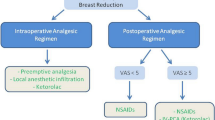Abstract
Background
Outpatient surgery is growing exponentially in different surgical areas, driven by cost savings and convenience for both the patient and the surgeon. Breast augmentation is one of the most commonly performed cosmetic surgical procedures and despite being a simple procedure, some surgeons prefer to keep the patient overnight, due to fear of complications and unsatisfactory pain and nausea management. The aim of this study was to compare postoperative complications, pain, nausea, and satisfaction between an outpatient and on 24-h hospitalization basis.
Methods
Eighty female patients undergoing breast augmentation were selected. Patients were allocated randomly, 40 patients each group. One group remained hospitalized for 24 h and the other group was discharged after surgery. In both groups were evaluated the following: complications, postoperative pain, nausea, and patient satisfaction with the recovery regime. Patients were followed up weekly within the first 4 weeks and then monthly. Pain evaluation was carried out using the pain scale proposed by Huskisson. A statistical analysis was also made.
Results
Eighty patients were operated, 40 patients in each group. There were no intraoperative complications in any group. In the hospital group, there was one case of hematoma (2.5%) and in the outpatient group, there was one case of infection (2.5%) (p = 1). Regarding postoperative pain, the average score was 3.9 in the hospital group and 4.1 in the outpatient group (p = 0.39). All patients in the outpatient group (100%) reported being satisfied with their recovery site and only 80% in the hospital group were satisfied (p = 0.002). Eight patients (20%) would rather have been discharged after the procedure.
Conclusions
Breast augmentation performed in an outpatient setting presented complication rates similar to conventional hospitalization, as well as levels of postoperative pain and nausea. However, there was a higher rate of patient’s satisfaction in the outpatient group.
Level of Evidence: Level I, risk / prognostic study.

Similar content being viewed by others
References
Santos JS, Sankarankutty AJ, Salgado Jr. W, et al. (2008) Cirurgia Ambulatorial: Do conceito à organização de serviços e seus resultados. Medicina, Ribeirão Preto 41(3):274–86
Alves EF (2010) Perfil dos atendimentos ambulatoriais realizados em uma clínica de cirurgia plástica no sul do Brasil. Revista Ciência & Saúde, Porto Alegre 3(2):45–51
Haeck PC, Swanson JA, Iverson RE (2009) Evidence-based patient safety advisory: patient selection and procedures in ambulatory surgery. Plast Reconstr Surg 124:6S–27S
The British Association of Aesthetic Plastic Surgeons. 2010 Cosmetic procedures statistics. Available at: http://www.baaps.org.uk/about-us/press-releases/584. Accessed 15 Jan 2017
American Society of Plastic Surgeons. 2010 plastic surgery pro¬cedural statistics. Available at: http://www.plasticsurgery.org/News-and-Resources/2011-Statistics-.html. Accessed 15 Jan 2017
Roxo AC, Nahas FX, Bazi F, de Castro CC, Aboudib JH, Marques RG (2016) Evaluation of the effects of sillicone implants on the breast parenchyma. Aesthet Surg J 137:62–69
American Society for Aesthetic Plastic Surgery. Cosmetic Surgery National Data Bank Statistics 2014. Available at: http://www.surgery.org/sites/default/files/2014. Accessed 15 Jan 2017
Reece EM, Ghavami A, Hoxworth RE, Alvarez SA, Hatef DA, Brown S, Rohrich RJ (2009) Primary breast augmentation today: a survey of current breast augmentation practice patterns. Aesthet Surg J 29:116–121
Stanley SS, Hoppe IC, Ciminello FS (2012) Pain control following breast augmentation: a qualitative systematic review. Aesthet Surg J 32(8):964–972
Klein DR, Rosenberg A (1981) Comparison of complications between in-hospital patients and out patients for aesthetic surgical procedures: a ten-year study. Plast Reconstr Surg 67(1):17–19
Adams WP Jr, Mallucci P (2012) Breast augmentation. Plast Reconstr Surg 130(4):597e–611e http://aplicacao.saude.gov.br/plataformabrasil/login.jsf. Accessed 17 Jan 2017
Huskisson EC (1974) Measurement of pain. Lancet v.2:1127–1131
Palumbo LT, Paul RE, Emery FB (1952) Results of primary inguinal hernioplasty. AMA Arch Surg 64:384–394
Davis JE, Sugioka K (1987) Selecting the patient for major ambulatory surgery. Surgical and anesthesiology evaluations. Surg Clin North Am 67:721–732
Tebbets JB (2002) Achieving a predictable 24-hour return to normal activities after breast augmentation: part I. Refining practices by using motion and time study principles. Plast Reconstr Surg 109:273–290
Swanson E (2013) Prospective outcome study of 225 cases of breast augmentation. Plast Reconstr Surg 131(5):1158–1166
Zhibo X, Miaobo Z (2009) Botulinum toxin type A infiltration for pain control after breast augmentation. Plast Reconstr Surg 124:263e–264e
Eldor L, Weissman A, Fodor L et al (2008) Breast augmentation under general anesthesia versus monitored anesthesia care: a retrospective comparative study. Ann Plast Surg 61:243–246
Arquero PS, Zanata FC, Ferreira LM, Nahas FX (2015) Capsular weakness around breast implant: a non-recognized complication. World J Plast Surg 4:168–174
Author information
Authors and Affiliations
Corresponding author
Ethics declarations
Ethical approval
The study was approved by the National Council of Ethics and Research under the number 34307314.3.0000.5259. All procedures performed in studies involving human participants were in accordance with the ethical standards of the institutional and/or national research committee and with the 1964 Helsinki declaration and its later amendments or comparable ethical standards.
Conflict of interest
Carlos Weck Roxo, Ana Claudia Weck Roxo, Fernando Serra, Denise da Mota, João Henrique Spagolla Pontello, Daniel Leal, José Horácio Aboudib, and Fábio X. Nahas declare that they have no conflict of interest.
Patient consent
All patients signed the consent statement before their inclusion in this study.
Funding
None.
Rights and permissions
About this article
Cite this article
Roxo, C.W., Roxo, A.C.W., Serra, F. et al. Comparison of pain, nausea, and complications in outpatient and inpatient breast augmentation. Eur J Plast Surg 41, 27–30 (2018). https://doi.org/10.1007/s00238-017-1316-9
Received:
Accepted:
Published:
Issue Date:
DOI: https://doi.org/10.1007/s00238-017-1316-9




